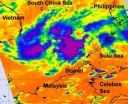Lithosphere is the newest bimonthly publication of The Geological Society of America, printing February, April, June, August, and October, and December each year. Abstracts are available at http://lithosphere.gsapubs.org/. Representatives of the media may obtain complimentary copies of Lithosphere articles by contacting Christa Stratton at the address above.
Please discuss articles of interest with the authors before publishing stories on their work, and please make reference to Lithosphere in articles published. Contact Christa Stratton for additional information or assistance.
Non-media requests for articles may be directed to GSA Sales and Service, gsaservice@geosociety.org.
Imprints of volcanism in the upper mantle beneath NW Deccan volcanic province
G. Mohan et al., Indian Institute of Technology Bombay, Dept. of Earth Sciences, Mumbai, 400076, India. Posted online 9 Jan. 2012; print issue: April 2012; doi: 10.1130/L178.1.
A major part of central and western India is covered by an over one-kilometer-thick pile of volcanic rocks (basalts), known popularly as the "Deccan Traps." The origin of this volcanism about 65 million years ago coincided with the global mass extinction of the plant and animal species, including the dinosaurs. Consequently, the theories for the genesis of the Deccan volcanism range from external meteorite impact to internal convection process in which hot material rises from the deep mantle to flood Earth's surface. G. Mohan and colleagues investigate the origin of the Deccan volcanism by exploring the interiors of Earth through seismic waves generated by earthquakes and recorded by seismographs on Earth's surface. They found the imprints of volcanism, due to a thermal source, preserved deep beneath the northwestern Deccan volcanic province (NWDVP), suggesting that the relatively thin lithosphere beneath NWDVP provided a favorable setting for the volcanic eruption. Mohan and colleagues hypothesize that the location and magnitude of volcanism are governed to a large extent by the variation in the thickness of the lithosphere beneath the DVP. This study provides seismological constraints on the models feasible for the genesis of flood basalts.
Transient fluvial incision and active surface uplift in the Woodlark Rift of Eastern Papua New Guinea
Scott R. Miller et al., Dept. of Earth Sciences, 204 Heroy Geology Laboratory, Syracuse University, Syracuse, New York 13244, USA. Posted online 25 Jan. 2012; print issue: April 2012; doi: 10.1130/L135.1.
The Woodlark Rift off-shore of eastern Papua New Guinea is the fastest extending continental crust on Earth. In the center of the rift, the D'Entrecasteaux Islands exceed elevations of 2,500 meters and include the youngest ultrahigh-pressure rocks on Earth, which were transported from more than 90 km deep since rifting began about eight million years ago. Even though the Woodlark Rift presents an unparalleled view into the processes that govern the rifting of continental crust, little is known about the history and spatial pattern of vertical bedrock motions over the past million years. Over this time, plate motions have changed significantly, with extension and rock uplift possibly migrating from the center of the rift to its southern margin on the Papuan Peninsula. In order to better understand the mechanisms that have brought deeply exhumed rocks to Earth's surface, a community of earth scientists has been working to understand the history and pattern of vertical rock motions within the Woodlark Rift. In this study, Scott Miller and colleagues present data about the lengthwise elevations of rivers draining the D'Entrecasteaux Islands and the Papuan Peninsula. These rivers are gauges that adjust their slopes in response to mountain-building processes, such that their profile shapes record patterns in the amount and history of rock uplift and, hence, fault motion. These river profiles indicate that the islands and the peninsula have increased in mean elevation, likely over the past few hundred thousand years. This study is part of a growing body of work that suggests that profound rock uplift continues to the present day in both the D'Entrecasteaux Islands and the Papuan Peninsula, driven by continental extension and upwelling, buoyant mantle.
Late Pleistocene structural evolution of the Camarillo fold belt: Implications for lateral fault growth and seismic hazard in Southern California
Duane E. DeVecchio et al., Earth Research Institute, University of California, Santa Barbara, CA 93106-9630, USA. Posted online 28 Feb. 2012; print issue: April 2012; doi: 10.1130/L136.1.
The Camarillo fold belt (CFB) in the Western Transverse Ranges poses a significant seismic hazard to nearly one million people living in Southern California, yet few published geologic or geochronological data from this fold belt exist. The CFB is composed of several actively growing folds that are developed along the western extent of the highly segmented Simi fault zone, which extends for 40 km through urbanized Ventura and Los Angeles Counties. This research includes five balanced cross sections that are used to determine the magnitude of fault and fold related deformation. In addition, eight new absolute ages on deformed sedimentary strata exposed at the surface and in three paleoseismic trenches are presented and used to quantify the local timing and rates of fault slip across the fold belt, which is critical to assessing earthquake hazard. The results presented by Duane E. DeVecchio and colleagues show that local deformed sedimentary strata are an order of magnitude younger than previously thought, fault slip rates are comparable to other study fold belts in Southern California (0.8-1.4 mm/yr), and discrete faults within the fold belt are younger toward the west. A model of punctuated lateral fault propagation is proposed to explain westward growth of the Simi fault, which occurs in discrete pulses that are separated by intervals of fault displacement accumulation and fold amplification during constant fault length conditions. Lateral fault growth is limited in space and time by an orthogonal north-striking fault set, which juxtaposes a series of west-plunging anticlines that decrease in structural relief and age toward the west.
Climate-controlled landscape evolution in the Western Transverse Ranges, California: Insights from Quaternary geochronology of the Saugus Formation and strath terrace flights
Duane E. DeVecchio et al., Earth Research Institute, University of California, Santa Barbara, California 93106-9630, USA. Posted online 28 Feb. 2012; print issue: April 2012; doi: 10.1130/L176.1.
The Las Posas and Ojai Valleys, located in the actively deforming Western Transverse Ranges of California, contain well-preserved flights of strath terraces and Quaternary aggradational strata (e.g., Saugus Formation) that when numerically dated provide insight into the tectonic, geomorphic, fluvial, and climatic histories of the region. This study by Duane E. DeVecchio and colleagues includes 14 new optically stimulated luminescence and 16 new terrestrial cosmogenic nuclide ages from the late Pleistocene to Holocene that record regional aggradation events and four intervals of strath terrace formation. Numerical data indicate that terrestrial Saugus strata (Camarillo Member) in the Las Posas Valley prograded over marine deposits at ca. 125-thousand years ago and ca. 80-thousand years ago and have an upper age limit of approx. 60-25 thousand years, which is locally an order of magnitude younger than the youngest Saugus strata elsewhere in Southern California. These results highlight the need for additional numerical dating of the Saugus Formation, which is commonly cited as the youngest strata deformed in numerous paleoseismic trenches, and its inferred upper age is used to quantify rates of regional tectonic deformation. Moreover, results discussed in this paper provide a chronostratigraphic framework from which these landforms may be correlated regionally and used for assessing rates of active tectonics where numerical data are unavailable.
Multi-timescale mechanical coupling between the San Jacinto fault and the San Andreas fault, southern California
G. Luo, Bureau of Economic Geology, Jackson School of Geosciences, The University of Texas at Austin, Austin, Texas 78713, USA, and M. Liu, Dept. of Geological Sciences, University of Missouri, Columbia, Missouri 65211, USA. Posted online 25 Jan. 2012 and not yet assigned to a print issue; doi: 10.1130/L180.1.
In Earth's upper crust, deformation is mostly accommodated by stick-and-slip on faults, producing recurrent earthquakes. Previous models have focused on stress buildup and release associated with the stick-and-slip process on individual fault segments; mechanical interaction between faults, while well expected, remains poorly understood. This paper by G. Luo and M. Liu explores mechanical coupling between the San Jacinto and southern San Andreas faults, which accommodate most of the relative North America-Pacific plate motion in southern California. The results show that the cluster of moderate-sized earthquakes on the San Jacinto fault in the past century may have delayed the "Big One" -- the anticipated rupture of much of the southern San Andreas fault -- by reducing the static Coulomb stress on the San Andreas fault. Furthermore, the fluctuation of seismic activity on one fault can significantly influence the loading rates on the other. Over longer time scales, the seismic moment release and slip rates on these two faults are complementary: Increase on one fault is associated with decrease on the other. Such results follow the principle of energy conservation and strain partitioning and are consistent with geological observations.
Chlorite-smectite clay minerals and fault behavior: new evidence from San Andreas Fault Observatory at Depth (SAFOD) core
A.M. Schleicher et al., University of Michigan, Geological Sciences, 1100 North University Ave, Ann Arbor, MI 48109, USA. Posted online 25 Jan. 2012 and not yet assigned to a print issue; doi: 10.1130/L158.1.
The presence of smectitic clay minerals has been advanced as evidence for mineralogic fault weakening processes in the San Andreas fault. However, the stability of pure smectite minerals is typically restricted to the uppermost 3-4 km of the upper crust. In this paper, A.M. Schleicher of the University of Michigan and colleagues explore the role of mixed layered chlorite-smectite minerals, which have been reported to exist to temperatures as high as 260 degrees Celsius with decreasing smectite content. The occurrence of localized chlorite-smectite phases in SAFOD fault-related rocks extends the role of fault weakening from clay neomineralizations to a greater range of depths and host rock compositions, influencing fault behavior down to a depth of 8-10 km. Schleicher and colleagues propose, therefore, that smectite-bearing clays and, in particular, the chlorite-smectite minerals can govern brittle fault behavior down to the brittle plastic transition.
Chalcedony vein horizons and clastic dikes in the White River Group as products of diagenetically driven deformation
Harmon Maher Jr. and Robert Shuster, Dept. of Geography and Geology, University of Nebraska, Omaha, Nebraska 68182-0199, USA. Posted online 25 Jan. 2012 and not yet assigned to a print issue; doi: 10.1130/L187.1.
Chalcedony veins occur as local stratabound arrays at multiple levels within the finer-grained sediments of the White River Group, making up to 2%-3% of the outcrop volume. The veins are commonly deformed by small folds, faults with well-developed striae, and various fold-fault combinations, and they also exhibit striae and slickenslides on vein walls. These indicate significant vertical shortening of the veins. Evidence for vertical dike shortening suggests synchronous or later compaction, and clastic dikes are also postulated to result from syneresis. Harmon Maher Jr. and Robert Shuster suggest that chalcedony vein formation, silica mobilization, local uranium mineralization, and clastic dike formation are part of diagenetically driven fracture development that produced a fluid flow network, initiating feedback relationships among diagenesis, dewatering, fluid migration, and associated compaction. Given that the clastic dikes occur within the Sharps Formation, the event was Miocene or later.
Crustal scale shortening structures beneath the Blue Ridge Mountains, NC, USA
Lara S. Wagner et al., University of North Carolina, Chapel Hill, NC 27599, USA. Posted online 28 Feb. 2012 and not yet assigned to a print issue; doi: 10.1130/L184.1.
Lara S. Wagner and colleagues use a unique seismic data set to study the crust and upper mantle beneath the Blue Ridge Mountains in North Carolina. There has been some debate about how the Southern Appalachians have maintained their rugged topography for more than 180 million years since the last major tectonic event along the eastern seaboard. The Blue Ridge Escarpment is a particularly striking example of the steep topography that one might imagine would have become more gradual over these very long time periods. Wagner and colleagues note that their results suggest there may be good reason for the high elevations and steep topography in the Blue Ridge Mountains related to variations in crustal thickness and composition. Specifically, they find that the highest elevations are isostatically supported by a 45 km thick crust. However, to the east of the escarpment, Wagner and colleagues find similar crustal thicknesses of about 45 km but also evidence for a 15-km-thick layer of very dense material beneath the crust that might serve to hold these lower elevations down. While these results are very preliminary, they offer an intriguing first look at how deeper lithospheric scale structures affect the persistence of ancient mountain ranges like the Southern Appalachians.
###
www.geosociety.org
END



